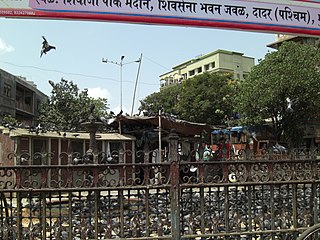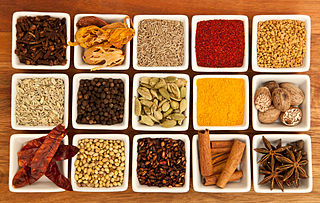
Halva refers to various local confection recipes. The name is used for referring to a huge variety of confections, with the most geographically common variety based on toasted semolina.

Dadar ([d̪aːd̪əɾ]) is the first planned area of Mumbai. It is a densely populated residential and shopping neighbourhood. It is also a prominent railway and bus service hub with local and national connectivity. Dadar is also a hub for the city's Marathi culture.

Mahim is a neighbourhood in Mumbai, India. The Mahim railway station is in the Mahim area, on the Mumbai suburban railway on the Western Railway line. Mahim is diverse and has a church, mosque and fire-temple existing within a few meters of each other.

Puri is a deep-fried bread made from unleavened whole-wheat flour that originated in the Indian subcontinent. It is eaten for breakfast or as a snack or light meal. It is usually served with a savory curry or bhaji, as in puri bhaji, but may also be eaten with sweet dishes.
Mithai (sweets) are the confectionery and desserts of the Indian subcontinent. Thousands of dedicated shops in India, Bangladesh, Nepal,Pakistan and Sri Lanka sell nothing but sweets.

Castella de Aguada, also known as the Bandra Fort, is a fort located in Bandra, Mumbai. "Castella" is a misspelling for Portuguese "Castelo" (castle), although it seems its Portuguese builders actually called it Forte de Bandorá. It is located at Land's End in Bandra. It was built by the Portuguese in 1640 as a watchtower overlooking Mahim Bay, the Arabian Sea and the southern island of Mahim. The strategic value of the fort was enhanced in 1661 after the Portuguese ceded the seven islands of Bombay that lay to the immediate south of Bandra to the English. The name indicates its origin as a place where fresh water was available in the form of a fountain ("Aguada") for Portuguese ships cruising the coasts in the initial period of Portuguese presence. The fort lies over several levels, from sea level to an altitude of 24 metres (79 ft). Castella de Aguada has been featured in several Hindi films, such as Dil Chahta Hai and Buddha Mil Gaya.

Maharashtrian or Marathicuisine is the cuisine of the Marathi people from the Indian state of Maharashtra. It has distinctive attributes, while sharing much with other Indian cuisines. Traditionally, Maharashtrians have considered their food to be more austere than others.

Udupi cuisine is a cuisine of South India. It forms an important part of Tuluva-Mangalorean cuisine and takes its name from Udupi, a city on the southwest coast of India in the Tulunadu region. Udupi cuisine is strictly vegetarian and has its origin in the Tulu Ashta Mathas of Udupi founded by Madhvacharya.

Khoa, khoya, khowa or mawa is a dairy food widely used in the cuisines of the Indian subcontinent, encompassing India, Nepal, Bangladesh and Pakistan. It is made of either dried whole milk or milk thickened by heating in an open iron pan. It is lower in moisture than typical fresh cheeses such as ricotta.
The 2006 Mumbai "sweet" seawater incident was a strange phenomenon during which residents of Mumbai claimed that the water at Mahim Creek had suddenly turned sweet. Within hours, residents of Gujarat claimed that seawater at Teethal beach had turned sweet as well. This caused a mass hysteria among people who started coming in large numbers to drink the sea water.

Mughlai cuisine consists of dishes developed in the medieval Indo-Persian cultural centres of the Mughal Empire. It represents a combination of cuisine of the Indian subcontinent with the cooking styles and recipes of Central Asian and Islamic cuisine. Mughlai cuisine is strongly influenced by the Turkic cuisine of Central Asia, the region where the early Mughal emperors originally hailed from, and it has in turn strongly influenced the regional cuisines of Northern India, Pakistan and Bangladesh.

Goan cuisine consists of regional foods popular in Goa, an Indian state located along India's west coast on the shore of the Arabian Sea. Rice, seafood, coconut, vegetables, meat, pork and local spices are some of the main ingredients in Goan cuisine. Use of kokum and vinegar is another distinct feature. Goan food is considered incomplete without fish.
Humans have inhabited Mumbai since the Stone Age. The Kolis and Aagri were the earliest known settlers of the islands. The Maurya Empire gained control of the islands during the 3rd century BCE and transformed them into a centre of Hindu-Buddhist culture and religion. Later, between the 2nd century BCE and 9th century CE, the islands came under the control of successive indigenous dynasties: the Satavahanas, Abhiras, Vakatakas, Kalachuris, Konkan Mauryas, Chalukyas, Rashtrakutas, and Silharas.

St. Michael's Church is one of the oldest Catholic churches in the Mahim suburb of Mumbai (Bombay), situated at the junction of LJ Road and Mahim Causeway. Initially known as San Miguel in Portuguese, the original structure was built by Franciscan missionaries of the Portuguese Church in 1534 AD, in what was then the Bombay and Bassein province. It was rebuilt a number of times; the present structure dating to 1973. The church also served as a refuge to the popular icon of the Virgin Mary from Our Lady of the Mount chapel, Bandra from 1739 to 1761.

Carrot pudding is a dish traditional to a wide range of cultures around the world. It can be served either as a savoury pudding or as a sweet dessert.

Gajar ka halwa, also known as gajorer halua, gajrela, gajar pak, and carrot halwa is a carrot-based sweet dessert pudding from the Indian subcontinent. It is made by placing grated carrots in a pot containing a specific amount of water, milk and sugar, cardamom and then cooking while stirring regularly. It is often served with a garnish of almonds and pistachios. The nuts and other items used are first sautéed in ghee, a type of clarified butter from the Indian subcontinent.

Lonavala chikki is an Indian sweet named after Lonavala, a town in Pune district of Maharashtra India. It is a type of chikki or guddani, a confection made from jaggery, ground nuts and ghee. The product was sold by Maganlal Agarwal from his sweet meat shop in Lonavala, and packaged by railway authorities and sold to train travellers between Lonavala and Mumbai. Encouraged by this, Agarwal renamed the product "Maganlal chikki", and it later became and continues to be called Lonavala chikki.
Bhagnaris are a Hindu Baloch community living in India. They trace their origin to Southern Balochistan. They migrated to India after Partition.











